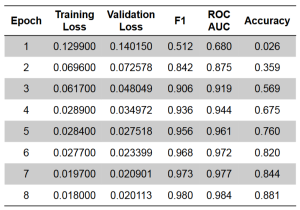The model’s performance was evaluated over 10 epochs, with a consistent decrease in both training and evaluation loss observed throughout the training process. Key metrics such as F1-score, ROC AUC, and accuracy were used to assess performance.
The model demonstrated strong classification performance by the eighth epoch, achieving an F1-score of 0.980, an ROC AUC of 0.984, and an accuracy of 0.881.
The stable decline in both training and evaluation loss indicated that the model was learning effectively and in the definitive training was halted at 8 epochs, as further fine-tuning offered only minimal improvements increasing the risk of overfitting.
